Visualizing Sustainability of Selective Mountain Farming Systems from Far-eastern Himalayas to Support Decision Making
Abstract
1. Introduction
2. Materials and Methods
2.1. Co-defining Impact Factors
2.2. Categorizing PIFs and NIFs into Components of Composite Indicators
2.3. Defining Farm-Performance Indicators
2.4. Selecting Sites for Assessing Sustainability
2.5. Participatory Exercises in Different Sites to Define Sustainability Space
2.6. Principal Component Analysis
3. Results and Discussions
3.1. Sustainability Spaces of Different Farming Systems
3.2. General Characteristic of Mountain Farming Systems in Terms of Seven Sustainability Space Components
3.3. Positive Impact Factors Enhacing Farm Sustainability
3.4. Negative Impact Factors Enhacing Farm Sustainability
4. Conclusions
Author Contributions
Funding
Acknowledgments
Conflicts of Interest
Appendix A. Categorization of PIFs and NIFs into Seven Sustainability Space Components
| PIFs | Sustainability Space Components | ||||||
|---|---|---|---|---|---|---|---|
| SO | IA | RE | AF | EP | SW | ES | |
| Agrobiodiversity | 83.33 | 70 | 83.33 | 100 | 80 | 63.33 | 66.67 |
| Ecosystem services management | 76.67 | 96.67 | 86.67 | 83.33 | 76.67 | 70 | 73.33 |
| Habitat Connectivity | 96.67 | 60 | 80 | 86.67 | 60 | 50 | 73.33 |
| Management of local resources | 83.33 | 66.67 | 100 | 80 | 76.67 | 86.67 | 50 |
| Use of interdisciplinary knowledge | 70 | 100 | 80 | 66.67 | 70 | 76.67 | 66.67 |
| Engagement of traditional institution | 73.33 | 60 | 93.33 | 70 | 56.67 | 83.33 | 33.33 |
| Land tenure and ownerships | 100 | 66.67 | 73.33 | 60 | 70 | 70 | 63.33 |
| Rural development infrastructure | 100 | 60 | 70 | 56.67 | 83.33 | 90 | 66.67 |
| Community motivation and interest | 76.67 | 80 | 93.33 | 76.67 | 73.33 | 86.67 | 40 |
| Intersectoral coordination | 66.67 | 100 | 83.33 | 50 | 66.67 | 56.67 | 90 |
| Farming community capacities, skills and practices | 70 | 80 | 66.67 | 90 | 63.33 | 83.33 | 50 |
| Inclusive growth | 73.33 | 60 | 70 | 90 | 76.67 | 93.33 | 63.33 |
| Social equity and cohesion | 70 | 50 | 83.33 | 76.67 | 63.33 | 100 | 50 |
| Incentives and subsidies | 33.33 | 66.67 | 50 | 86.67 | 73.33 | 80 | 80 |
| Agri-enterpreneurships | 63.33 | 86.67 | 66.67 | 66.67 | 100 | 83.33 | 80 |
| Financial infrastructures and services | 50 | 70 | 76.67 | 70 | 100 | 83.33 | 70 |
| Market infrastructure and services | 66.67 | 73.33 | 76.67 | 70 | 100 | 80 | 80 |
| Technological infrastructure and support | 63.33 | 80 | 63.33 | 76.67 | 70 | 80 | 100 |
| Access to development facilities | 76.67 | 60 | 83.33 | 80 | 73.33 | 100 | 73.33 |
| R&D programmes and schemes | 66.67 | 90 | 76.67 | 73.33 | 66.67 | 73.33 | 100 |
| Agriculture extension services | 63.33 | 83.33 | 50 | 70 | 73.33 | 76.67 | 93.33 |
| NIFs | Sustainability Space Components | ||||||
|---|---|---|---|---|---|---|---|
| SO | IA | RE | AF | EP | SW | ES | |
| Extent of unused land due to labour shortage | 100 | 70 | 96.7 | 66.7 | 80 | 80 | 63.3 |
| Conflict with forests and other land use | 86.7 | 80 | 76.7 | 73.3 | 56.7 | 86.7 | 93.3 |
| Floods and landslides | 100 | 56.7 | 76.7 | 70 | 63.3 | 76.7 | 63.3 |
| Extent of pest and disease | 46.7 | 93.3 | 66.7 | 70 | 86.7 | 76.7 | 46.7 |
| Inadequate capacities to integrated soil/water management | 80 | 96.7 | 80 | 90 | 66.7 | 93.3 | 73.3 |
| loss of local cultivars and breeds | 66.7 | 60 | 86.7 | 90 | 46.7 | 80 | 63.3 |
| Use of pesticides and chemical fertilizers | 60 | 63.3 | 93.3 | 53.3 | 86.7 | 63.3 | 66.7 |
| Extent of migration of farming families | 86.7 | 50 | 96.7 | 56.7 | 90 | 90 | 70 |
| Use of hybrid and genetically improved crops | 60 | 56.7 | 66.7 | 93.3 | 80 | 63.3 | 83.3 |
| Water stress | 70 | 90 | 93.3 | 86.7 | 73.3 | 90 | 66.7 |
| Inadequate capacities to start agribusiness | 63.3 | 83.3 | 80 | 66.7 | 100 | 96.7 | 80 |
| Market price fluctuation | 30 | 56.7 | 83.3 | 66.7 | 100 | 93.3 | 70 |
| Interest towards off-farm livelihoods | 73.3 | 56.7 | 93.3 | 56.7 | 90 | 96.7 | 66.7 |
| Lack of motivation and support for farming communities | 66.7 | 73.3 | 90 | 53.3 | 76.7 | 100 | 53.3 |
| Crop depredation | 46.7 | 70 | 46.7 | 43.3 | 56.7 | 86.7 | 46.7 |
| Top soil erosion and changing of soil structure | 90 | 76.7 | 80 | 83.3 | 70 | 66.7 | 73.3 |
References
- Ramakrishnan, P.S. An integrated approach to land use management for conserving agroecosystem biodiversity in the context of global change. Int. J. Agric. Res. Gov. Ecol. 2000, 1, 56–67. [Google Scholar] [CrossRef]
- Pretty, J. Agricultural sustainability: Concepts, principles and evidence. Philos. Trans. R. Soc. B Biol. Sci. 2008, 363, 447–465. [Google Scholar] [CrossRef]
- Pratap, T. Mountain Agriculture, Marginal Lands, and Sustainable Livelihoods: Challenges and Opportunities. In Mountain Agriculture in the Hindu Kush-Himalayan Region; Ya, T., Tulachan, P., Eds.; ICIMOD: Kathmandu, Lalitpur, Nepal, 2003. [Google Scholar]
- Harwood, R.R. Sustainability in Agricultural Systems in Transition—At What Cost? America Society of Agronomy, Crop Science Society of America, Soil Science Society of America; World Bank: Baltimore, MD, USA, 1998. [Google Scholar]
- Hazell, P.; Poulton, C.; Wiggins, S.; Dorward, A. The Future of Small Farms: Trajectories and Policy Priorities. World Dev. 2010, 38, 1349–1361. [Google Scholar] [CrossRef]
- Jiao, X.; Mongol, N.; Zhang, F. The transformation of agriculture in China: Looking back and looking forward. J. Integr. Agric. 2018, 17, 755–764. [Google Scholar] [CrossRef]
- Sharma, H.R.; Chauhan, S.K. Agricultural Transformation in Trans Himalayan Region of Himachal Pradesh: Cropping Pattern, Technology Adoption and Emerging Challenges. Agric. Econ. Res. Rev. 2013, 26, 173–179. [Google Scholar]
- Rao, N.H.; Rogers, P.P. Assessment of agricultural sustainability. Curr. Sci. 2006, 91, 439–448. [Google Scholar]
- Food and Agriculture Organization of the United Nations (FAO). Why Invest in Sustainable Mountain Development? FAO: Roma, Italy, 2011. [Google Scholar]
- World Commission on Environment and Development (WCED). Our Common Future; WCED: Oxford, UK; New York, NY, USA, 1987.
- Stirling, A.; Leach, M.; Mehta, L.; Scoones, I.; Smith, A.; Stagl, S.; Thompson, J. Empowering Designs: Towards More Progressive Appraisal of Sustainability; STEPS Working Paper 3; STEPS Centre: Brighton, UK, 2007; pp. 1–72. [Google Scholar]
- Wuelser, G.; Pohl, C.; Hadorn, G.H. Structuring complexity for tailoring research contributions to sustainable development: A framework. Sustain. Sci. 2012, 7, 81–93. [Google Scholar] [CrossRef]
- Lang, D.J.; Wiek, A.; Bergmann, M.; Stauffacher, M.; Martens, P.; Moll, P.; Swilling, M.; Thomas, C.J. Transdisciplinary research in sustainability science: Practice, principles, and challenges. Sustain. Sci. 2012, 7, 25–43. [Google Scholar] [CrossRef]
- Schneider, F.; Bonriposi, M.; Graefe, O.; Herweg, K.; Homewood, C.; Huss, M.; Kauzlaric, M.; Liniger, H.; Rey, E.; Reynard, E.; et al. Assessing the sustainability of water governance systems: The sustainability wheel. J. Environ. Plan. Manag. 2015, 58, 1577–1600. [Google Scholar] [CrossRef]
- Schneider, F. Promising degrees of stakeholder interaction in research for sustainable development. Sustain. Sci. 2018, 13, 129–142. [Google Scholar] [CrossRef] [PubMed]
- Peano, C.; Tecco, N.; Dansero, E.; Girgenti, V.; Sottile, F. Evaluating the sustainability in complex agri-food systems: The SAEMETH framework. Sustainability 2015, 7, 6721–6741. [Google Scholar] [CrossRef]
- Hayati, D. A Literature Review on Frameworks and Methods for Measuring and Monitoring Sustainable Agriculture; Global Strategy Technical Report: Rome, Italy, 2017. [Google Scholar]
- Mottet, A.; Ladet, S.; Coqué, N.; Gibon, A. Agricultural land-use change and its drivers in mountain landscapes: A case study in the Pyrenees. Agric. Ecosyst. Environ. 2006, 114, 296–310. [Google Scholar] [CrossRef]
- Lélé, S.; Norgaard, R.B. Practicing Interdisciplinarity. Bioscience 2005, 55, 967. [Google Scholar] [CrossRef]
- Olsson, P.; Folke, C.; Berkes, F. Adaptive comanagement for building resilience in social-ecological systems. Environ. Manag. 2004, 34, 75–90. [Google Scholar] [CrossRef] [PubMed]
- Häni, F.; Braga, F.; Stämpfli, A.; Keller, T. RISE, a Tool for Holistic Sustainability Assessment at the Farm Level. Int. Food Agribus. Manag. Rev. 2003, 6, 78–90. [Google Scholar]
- Axelsson, R.; Angelstam, P.; Elbakidze, M.; Stryamets, N.; Johansson, K.-E. Sustainable Development and Sustainability: Landscape Approach as a Practical Interpretation of Principles and Implementation Concepts. J. Landsc. Ecol. 2011, 4, 5–30. [Google Scholar] [CrossRef]
- Moller, H.; Macleod, C.J. Design criteria for effective assessment of sustainability in New Zealand’s production landscapes. N. Z. Sustain. Dashboard Res. Rep. 2013, 13, 73. [Google Scholar]
- Bossel, H. Indicators for Sustainable Development: Theory, Method, Applications; Intl Institute for Sustainable: Winnipeg, ON, Canada, 1999; Volume 68. [Google Scholar]
- Segnon, A.C.; Achigan-Dako, E.G.; Gaoue, O.G.; Ahanchédé, A. Farmer’s knowledge and perception of diversified farming systems in sub-humid and semi-arid areas in Benin. Sustainability 2015, 7, 6573–6592. [Google Scholar] [CrossRef]
- Koohafkan, P.; Altieri, M.A.; Holt Gimenez, E. Green Agriculture: Foundations for biodiverse, resilient and productive agricultural systems. Int. J. Agric. Sustain. 2012, 10, 61–75. [Google Scholar] [CrossRef]
- Jolliffe, I.; Cadima, J. Principal component analysis: A review and recent developments. Philos. Trans. R. Soc. A Math. Phys. Eng. Sci. 2016, 374, 20150202. [Google Scholar] [CrossRef]
- Liu, C.; Wu, B. “Grain for Green Programme” in China: Policy Making and Implementation? Briefing series-Issue 60; University of Nottingham, China Policy Institute: Nottingham, UK, 2010; pp. 1–17. [Google Scholar]
- Scherr, S.J.; McNeely, J.A. Biodiversity conservation and agricultural sustainability: Towards a new paradigm of “ecoagriculture” landscapes. Philos. Trans. R. Soc. B Biol. Sci. 2008, 363, 477–494. [Google Scholar] [CrossRef]
- Sharma, G.; Rai, L.K. Climate Change and Sustainability of Agrodiversity in Traditional Farming of the Sikkim Himalaya. In Climate Change in Sikkim Patterns, Impacts and Initiatives; Information and Public Relations Department, Government of Sikkim: Gangtok, India, 2012; pp. 193–218. [Google Scholar]
- Dollo, M.; Samal, P.K.; Sundriyal, R.C.; Kumar, K. Environmentally Sustainable Traditional Natural Resource Management and Conservation in Ziro Valley, Arunachal Himalaya, India. J. Am. Sci. 2009, 5, 41–52. [Google Scholar]
- Bisht, I.S.; Mehta, P.S.; Bhandari, D.C. Traditional crop diversity and its conservation on-farm for sustainable agricultural production in Kumaon Himalaya of Uttaranchal State: A case study. Genet. Resour. Crop Evol. 2007, 54, 345–357. [Google Scholar] [CrossRef]
- Deb, S.; Lynrah, M.M.; Tiwari, B.K. Technological innovations in shifting agricultural practices by three tribal farming communities of Meghalaya, northeast India. Trop. Ecol. 2013, 54, 133–148. [Google Scholar]
- Cáceres, D.M.; Tapella, E.; Quétier, F.; Díaz, S. The social value of biodiversity and ecosystem services from the perspectives of different social actors. Ecol. Soc. 2015, 20, 62. [Google Scholar] [CrossRef]
- Kremen, C.; Iles, A.; Bacon, C. Diversified farming systems: An agroecological, systems-based alternative to modern industrial agriculture. Ecol. Soc. 2012, 17. [Google Scholar] [CrossRef]
- Jonas, A.; Vanclay, F.; Imperiale, A.J.; Vanclay, F. Sustainable Rural Development in Mountain Areas Using Social Impact Assessment to Strengthen Community Resilience in Sustainable Rural Development in Mountain Areas. Mt. Res. Dev. 2016, 36, 431–442. [Google Scholar] [CrossRef]
- Thies, E. Incentive Measures Appropriate to Enhance the Conservation and Sustainable Use of Agrobiodiversity; Deutsche Gesellschaft für Technische Zusammenarbeit (GTZ): Eschborn, Germany, 2000; p. 36. [Google Scholar]
- Satyal, P.; Shrestha, K.; Ojha, H.; Vira, B.; Adhikari, J. A new Himalayan crisis? Exploring transformative resilience pathways. Environ. Dev. 2017, 23, 47–56. [Google Scholar] [CrossRef]
- Nicholls, T.; Elouafi, I.; Borgemeister, C.; Campos-Arce, J.J.; Hermann, M.; Hoogendoorn, J.; Keatinge, J.D.H.; Kelemu, S.; Molden, D.J.; Roys, A. Transforming Rural Livelihoods and Landscapes: Sustainable Improvements to Incomes, Food Security and the Environment; White Paper; Association of International Research and Development Centers for Agriculture (AIRCA): Nairobi, Kenya, 2013. [Google Scholar]
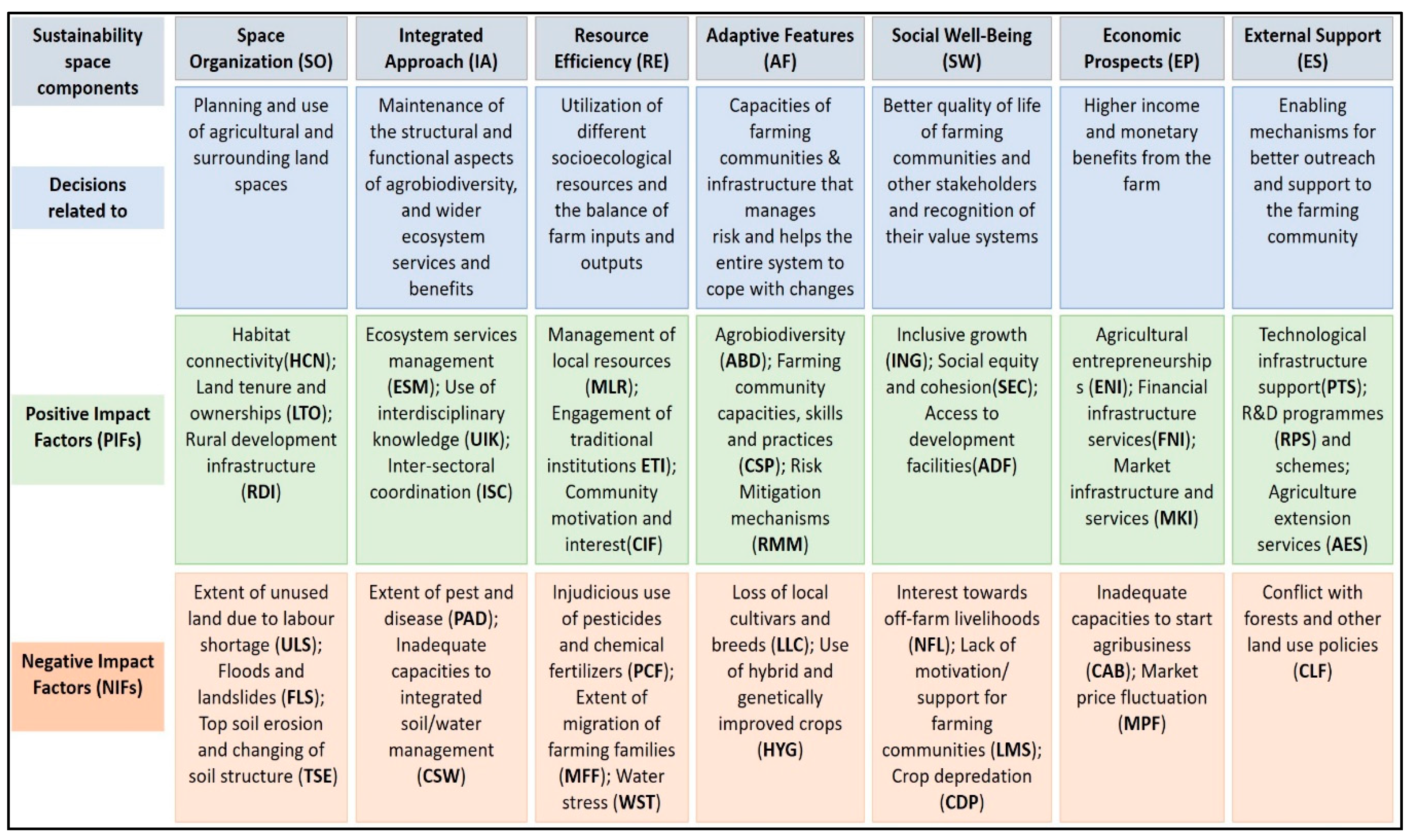

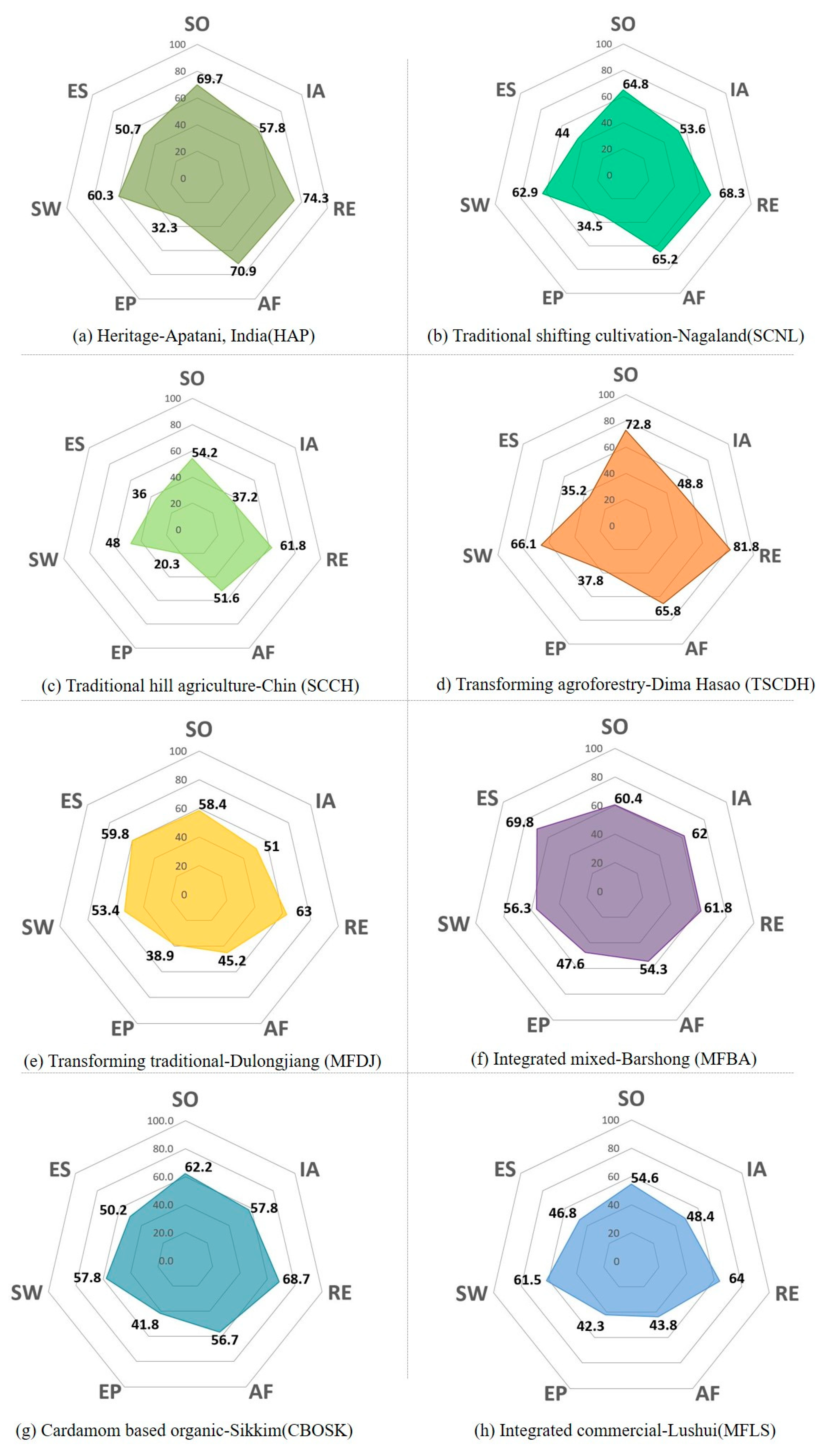

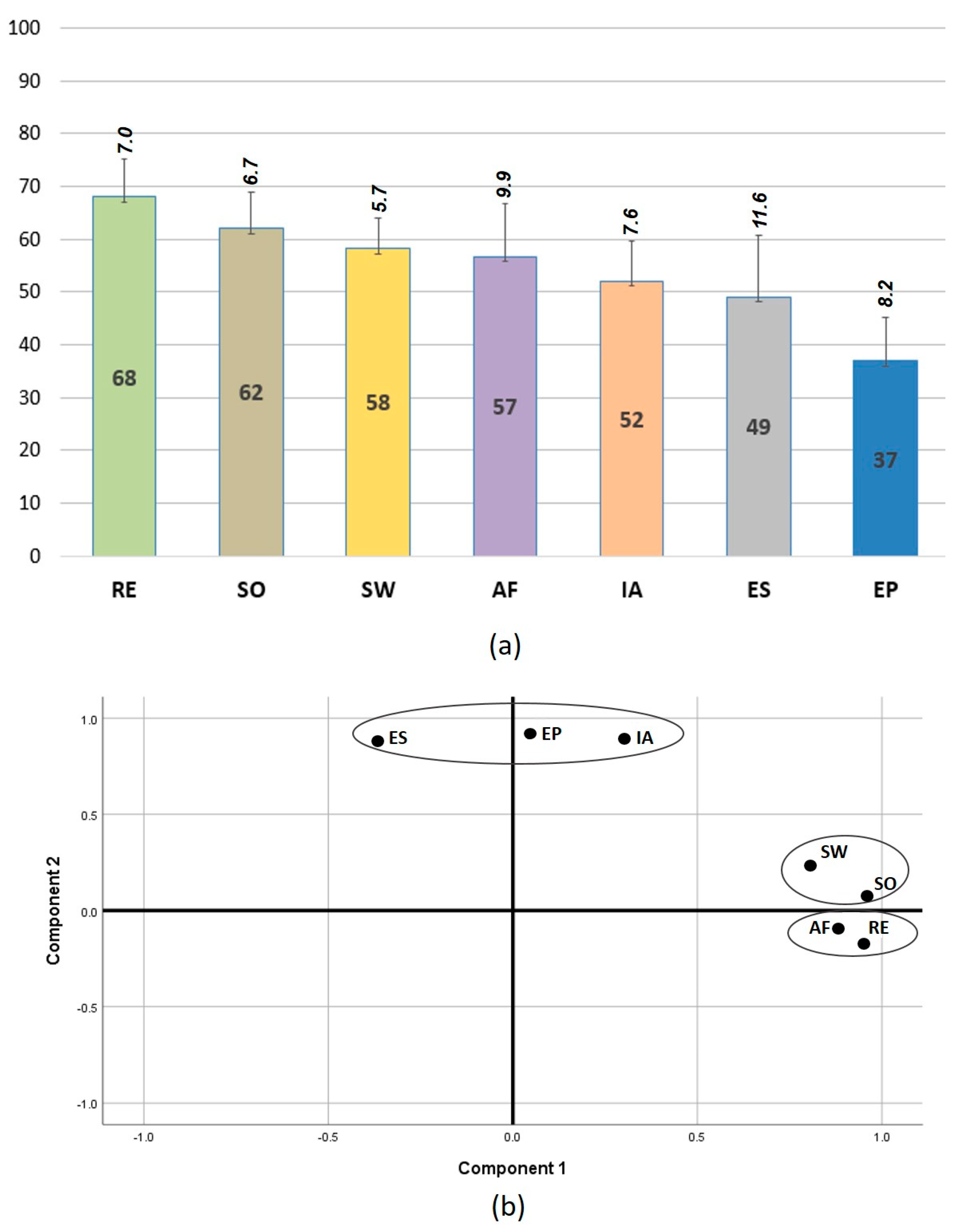
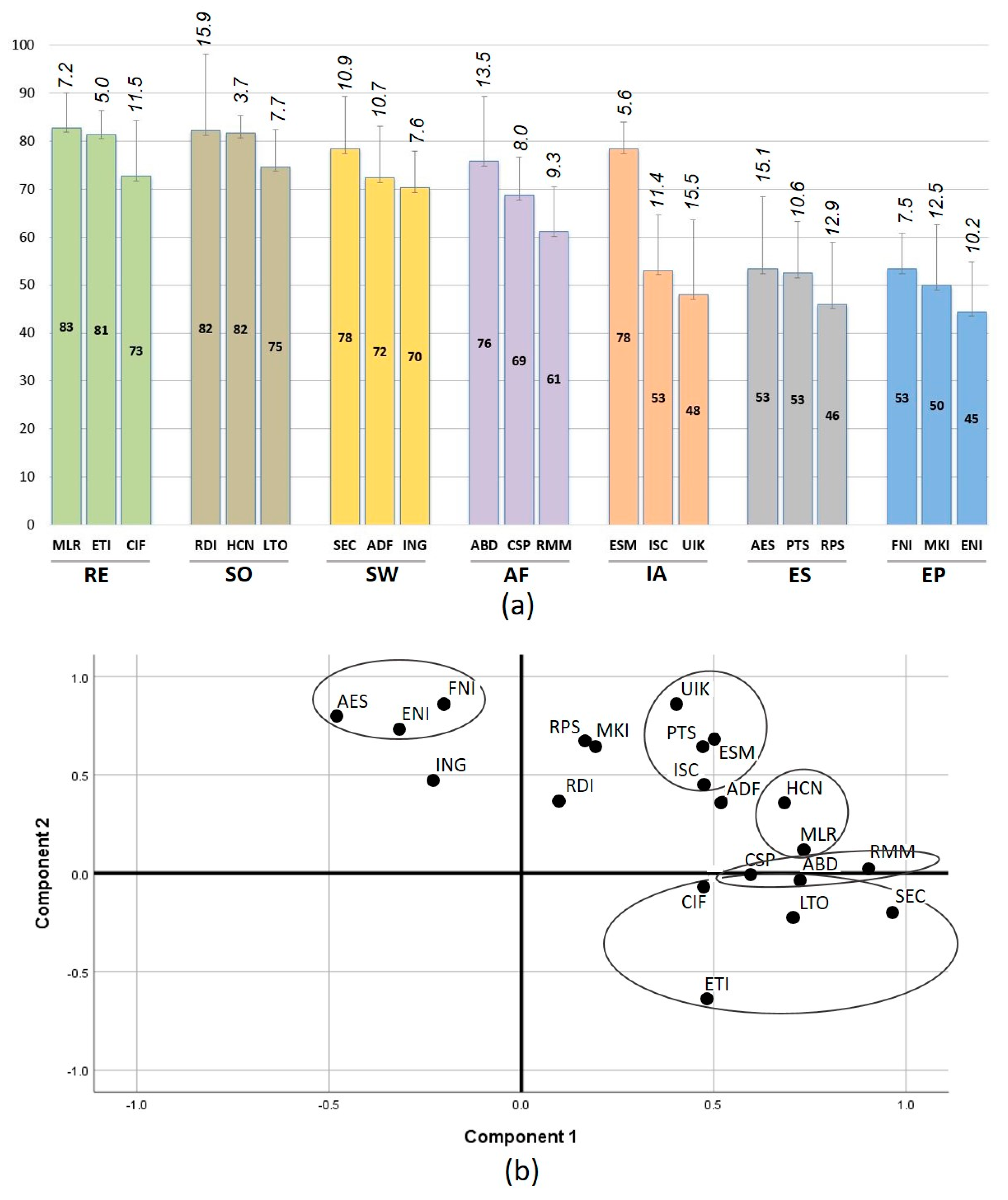
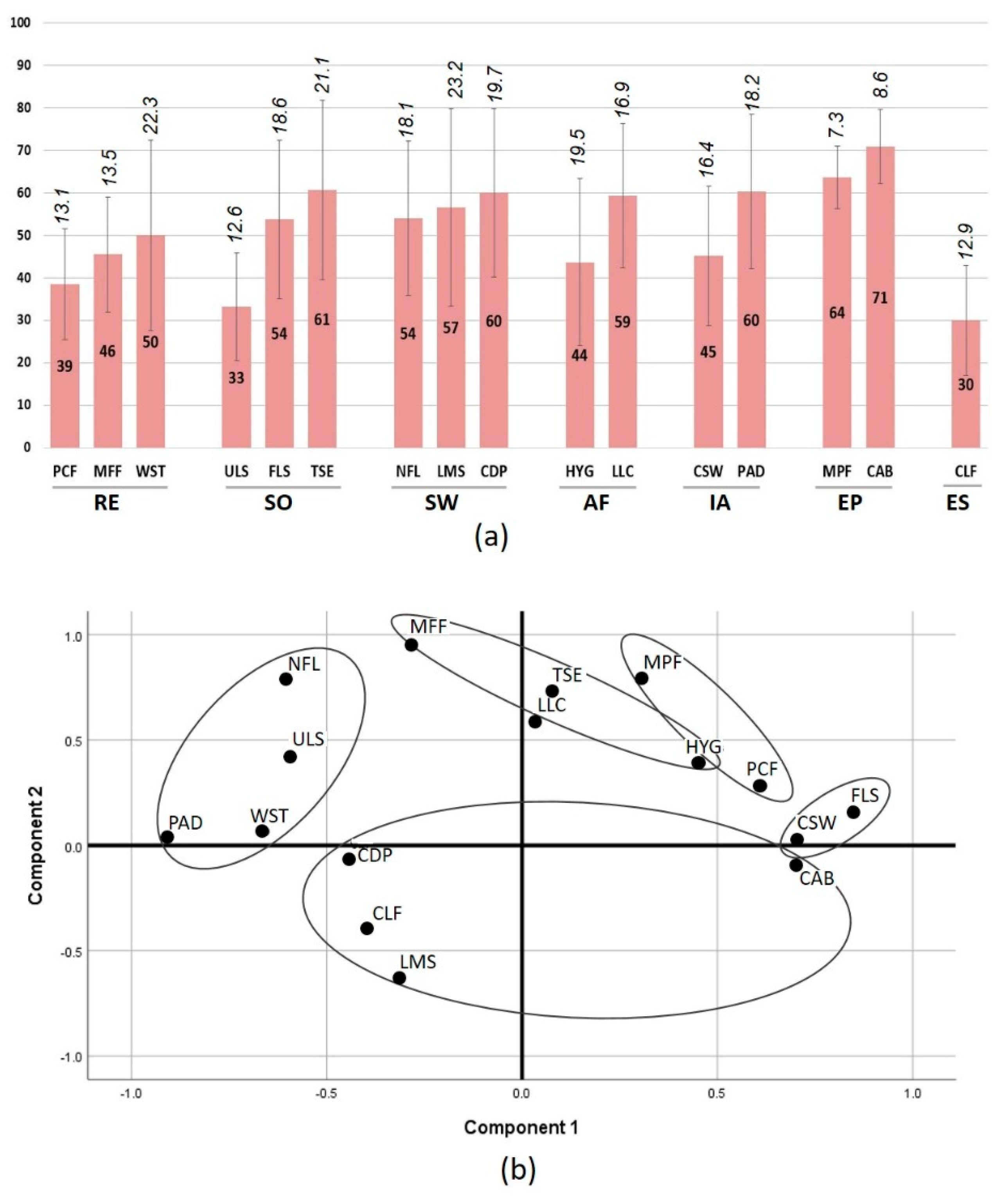
| Logic | PIFs (= reinforces sustainability) | NIFs (= hinders sustainability) |
|---|---|---|
| Environmental pillar | 1. Agrodiversity (ABD); 2. Habitat connectivity (HCN); 3. Ecosystem services maintenance (ESM) | 1.Loss of local cultivars and breeds (LLC); 2. Pest and diseases (PAD); 3. Use of hybrids and genetically improved crops against local varieties (HYG) |
| Geo-physical prerequisites | 4. Land-tenure and Ownerships (LTO); 5. Rural Development Infrastructure (RDI); 6. Management of local resources (MLR) | 4. Topsoil erosion and changing soil structure (TSE); 5. Water stress due to drought and dry spell (WST); 6.Floods and landslides (FLS) |
| Socio-cultural pillar | 7. Engagement of traditional institutions (ETI); 8. Use of interdisciplinary knowledge (UIK); 9. Capacities, skills and practices (CSP); 10. Social Equity and Cohesion (SEC) | 7. Inadequate capacities for soil-water management (CSW); 8. Injudicious use of pesticides and chemical fertilizers (PCF) |
| Community well-being prerequisites | 11. Inclusive growth (ING); 12. Community interest in developing farm resources (CIP); 13. Risk management mechanisms (RMM); 14. Access to development facilities (ADF) | 9. Interest towards off-farm livelihoods-changing aspirations (NFL); 10. Crop depredation (CDP); 11. Unused land due to labour shortage (ULS); 12. Migration of farming families out of farming (MFF) |
| Economic pillar | 15. Agribusiness entrepreneurships (ENI); 16. Financial infrastructure (FNI); 17. Market infrastructure (MKI) | 13. Inadequate capacities for agribusiness (CAB); 14. Market price fluctuations (MPF) |
| Government support | 18. Intersectoral coordination (ISC); 19. Agriculture extension services (AES); 20. R&D Programmes and Schemes (RPS); 21. Policy and technological support (PTS) | 15. Conflict in land-use policy (CLF); 16. Lack of conservation support for agrobiodiversity (LMS) |
| 21 PIFs | Farm Performance Indicators |
|---|---|
| Agrodiversity (ABD) | 1. Diversity of crop and livestock species; 2. Diversity of varieties, cultivars, and landraces; 3. Extent of local commodities and niche products |
| Habitat connectivity (HCN) | 4. Extent of nearby/adjoining forests; 5. Extent of nearby/adjoining wetlands; 6. Extent of use of a variety of production habitats; 7. Connectivity of farming land with other natural land use |
| Ecosystem services management (ESM) | 8. Soil nutrient management; 9. Carbon services management; 10. Water management; 11. Integrated pest management |
| Land-tenure and Ownerships (LTO) | 12. Land allocation per household; 13. Extent of land under traditional crop cultivation; 14. Extent of land under cash crop cultivation; 15. Compliance with other land uses |
| Rural Development Infrastructure (RDI) | 16. Road network and transportation facilities |
| Management of local resources (MLR) | 17. Availability of fodder throughout the year; 18. Availability of staple and nutritious food; 19. Availability of water for home and farm; 20. Dependence and use of locally available material; 21. Use of inputs from forests and wetlands |
| Engagement of traditional institutions (ETI) | 22. Availability of in-kind help and support within community; 23. Availability and organization of labour force; 24. Activeness of institutions to transfer knowledge from elder to younger generation |
| Use of interdisciplinary knowledge (UIK) | 25. Extent of use and application of low-cost technologies; 26. Trying of new generation crops from wild relatives |
| Capacities, skills and practices (CSP) | 27. Extent of use of traditional knowledge and practices; 28. Availability of modern knowledge and technical skills |
| Social Equity and Cohesion (SEC) | 29. Extent of festivals related to farming practices; 30. Extent of community institutions and network; 31. Importance of local culture and cuisine; 32. Interest, motivation towards agriculture and farming |
| Inclusive growth (ING) | 33. Good income and purchasing power; 34. Engagement of women in agribusiness; 35. Opportunity to engage and participate in farm management programmes; 36. Satisfaction over market price of farm produce |
| Community interest in developing farm resources (CIF) | 37. Interest towards growing local crop types/varieties; 38. Use and promotion of wild edibles; 39. Extent of investment by communities in agribusiness |
| Risk management mechanisms (RMM) | 40. Access to wider genetic resource base; 41. Crop/livestock Insurance and compensation mechanisms; 42. Effective post- harvest mechanisms for essential produce; 43. Access to forests/wetlands resources; 44. Provision of Community seed fair or Diversity seed fair; 45. Farmers network for seed exchange |
| Access to development facilities (ADF) | 46. Access to basic health, education, home, energy; 47. Access to local market for selling farm produce; 48. Access to market information |
| Agribusiness entrepreneurships (ENI) | 49. Private sector support and engagement; 50. Large scale community participation for cash crop cultivation; 51. Partnerships with value chain actors; 52. Extent of microenterprise and small-scale industry |
| Financial infrastructure (FNI) | 53. Profitable return of investment from agriculture; 54. Access to finance; 55. Provision of cash income from agriculture; 56. Buy back mechanism and support |
| Market infrastructure (MKI) | 57. Demand for local niche products in the market; 58. Connect to international market and trade; 59. Certification for local niche products |
| Intersectoral coordination (ISC) | 60. Research collaboration between farmers and research institutions; 61. Engagement of farming communities in forest management; 62. Maintenance of agriculture for heritage tourism; 63. Inclusive value chain mechanism and processes |
| Agriculture extension services (AES) | 64. Information Technological support; 65. Support with uptake of technology; 66. Support for crop variety development in farmers field; 67. Extension services infrastructure and facility |
| R&D Programmes and Schemes (RPS) | 68. Extent of capacity strengthening programmes for farmers in integrated farm management; 69. Support for organic/eco-farming; 70. Ex-situ conservation support for traditional landraces and germplasm |
| Policy and technological support (PTS) | 71. Recognition of traditional knowledge and rights; 72. Promotion of agricultural system as a globally important agricultural heritage site; 73. Policy support from government; 74. Weather information support at local level. |
© 2019 by the authors. Licensee MDPI, Basel, Switzerland. This article is an open access article distributed under the terms and conditions of the Creative Commons Attribution (CC BY) license (http://creativecommons.org/licenses/by/4.0/).
Share and Cite
Shakya, B.; Shrestha, A.; Sharma, G.; Gurung, T.; Mihin, D.; Yang, S.; Jamir, A.; Win, S.; Han, X.; Yang, Y.; et al. Visualizing Sustainability of Selective Mountain Farming Systems from Far-eastern Himalayas to Support Decision Making. Sustainability 2019, 11, 1714. https://doi.org/10.3390/su11061714
Shakya B, Shrestha A, Sharma G, Gurung T, Mihin D, Yang S, Jamir A, Win S, Han X, Yang Y, et al. Visualizing Sustainability of Selective Mountain Farming Systems from Far-eastern Himalayas to Support Decision Making. Sustainability. 2019; 11(6):1714. https://doi.org/10.3390/su11061714
Chicago/Turabian StyleShakya, Bandana, Anil Shrestha, Ghanashyam Sharma, Tulsi Gurung, Dollo Mihin, Shuo Yang, Amba Jamir, Soe Win, Xi Han, Yongping Yang, and et al. 2019. "Visualizing Sustainability of Selective Mountain Farming Systems from Far-eastern Himalayas to Support Decision Making" Sustainability 11, no. 6: 1714. https://doi.org/10.3390/su11061714
APA StyleShakya, B., Shrestha, A., Sharma, G., Gurung, T., Mihin, D., Yang, S., Jamir, A., Win, S., Han, X., Yang, Y., Choudhury, D., & Schneider, F. (2019). Visualizing Sustainability of Selective Mountain Farming Systems from Far-eastern Himalayas to Support Decision Making. Sustainability, 11(6), 1714. https://doi.org/10.3390/su11061714





